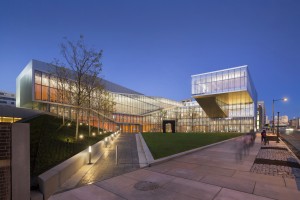Architects Bring Sunshine Into Nanotech Labs is the title for Sammy Medina’s Fast Company article about the University of Pennsylvania’s mind-blowing Krishna P. Singh Center for Nanotechnology,
That’s a very pretty image but here’s what makes it mind-blowing (from Medina’s article; Note: A link has been removed),
The building, by architecture office Wisss/Manfredi, “turns the paradigm of the laboratory inside out.” So says Marion Weiss, co-partner, along with Michael Manfredi, of the New York-based firm. “Most nanotechnology facilities are often in fairly remote locations, like Cornell’s,” Manfredi explains. “[O]r if they are in an urban campus, their signature spaces aren’t easily discovered.”
… The building’s most spectacular architectural moments are pushed to the fore, most notably in the 68-foot-deep cantilever that juts out over the ground-level lawn. The expansive facade glitters, in Weiss’s words, “like a cracked-open geode,” refracting scattered shards of light this way and that.
… Scientists can be seen from the courtyard through the structure’s three layers of glass, where they appear behind a wide amber glass partition ambling about like extras in a science fiction film. (As is standard, the laboratories themselves are wrapped in amber-tinted screens or windows, whose color protects against the sun’s rays. Only here, the architects tinted entire glass walls, rendering the lab space shockingly transparent.) Outside, in the atrium-like “galleria,” digital projections blow up microscopic images sourced from the scientists’ instruments and display them to the campus beyond. [emphasis mine]
This theme of scale is, naturally, very much inscribed in the project. The disparity between the building and the forms of nanotechnology it contains is ripe for creative interpretation … [emphasis mine]
The October 2, 2013 University of Pennsylvania news release about the Oct. 4, 2013 opening of the Krishna P. Singh Center for Nanotechnology provides details complementary to the information in Medina’s article (Note: Links have been removed),
Faculty from the School of Engineering and Applied Science, the School of Arts and Sciences, and across the University will make use of the Singh Center’s characterization and fabrication suites. Each of the two 10,000-square-foot facilities is filled with state-of-the-art equipment and designed to enable the high-precision techniques that research at the smallest scales necessitates.
The characterization facility is situated on bedrock, 18 feet below the surface, to help minimize vibrations that would interfere with its various atomic and electron microscopes. Its labs are also designed to be isolated from temperature fluctuations, atmospheric turbulence, and electromagnetic noise.
The fabrication facility on the Singh Center’s ground floor contains a next-generation cleanroom. Once in isolation garb, researchers will use its assembly tools to grow carbon nanotubes, deposit graphene, and etch microelectronic systems, among many other applications. The facility’s photolithography equipment is shielded from interfering ultraviolet light by a pane of marigold glass, which gives the Center its signature color.
I recommend reading Medina’s article if you want to find out more about how the architects approached the project and if you want to see more pictures.
